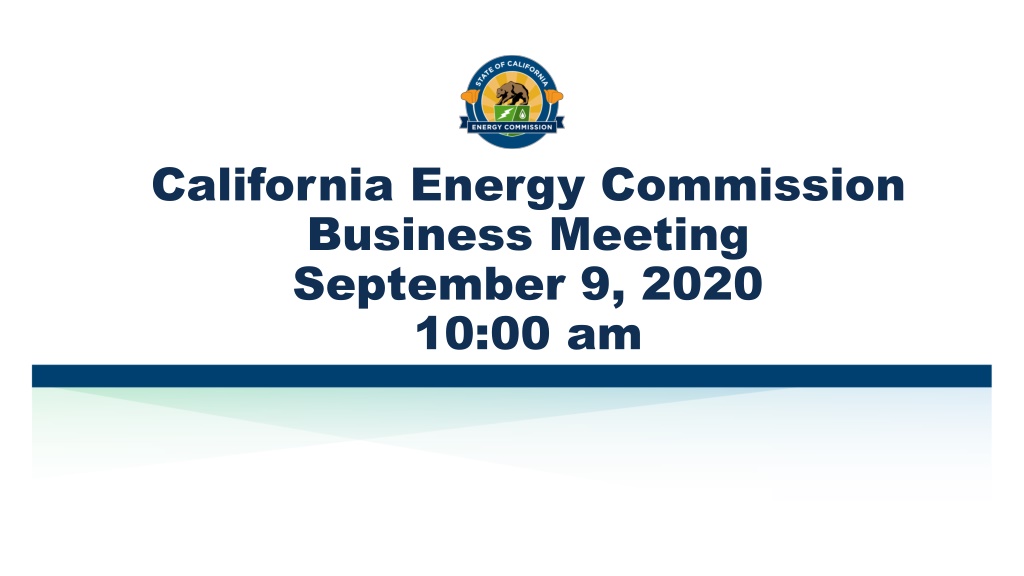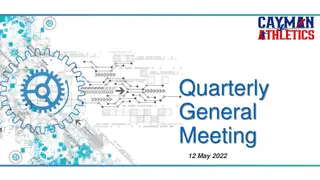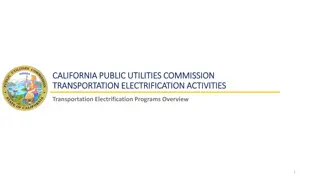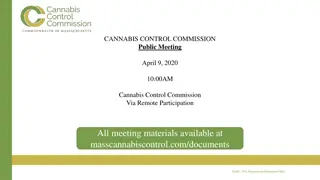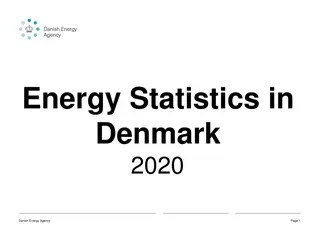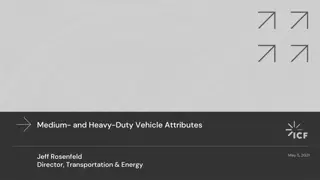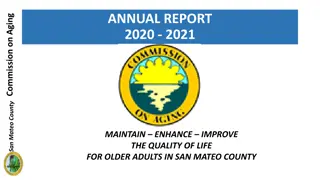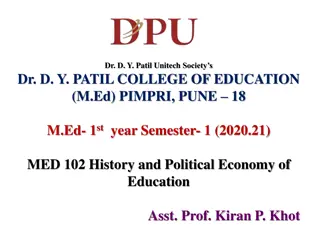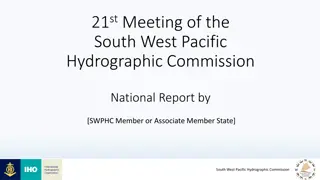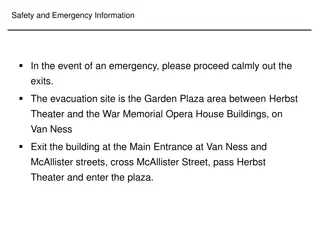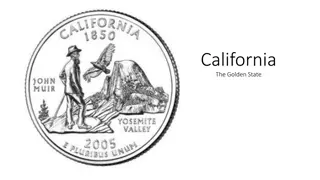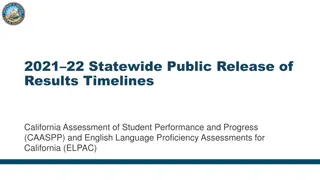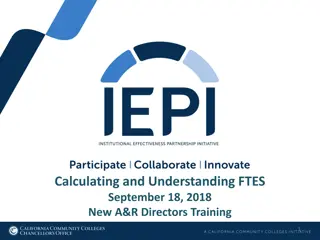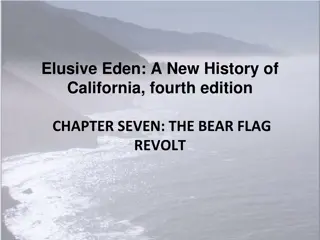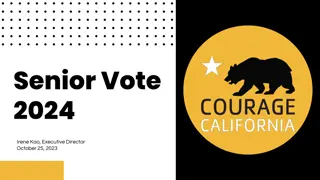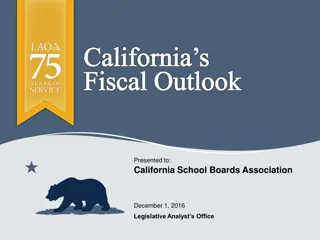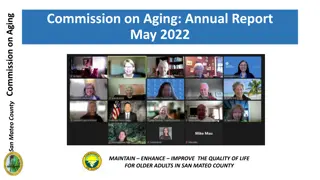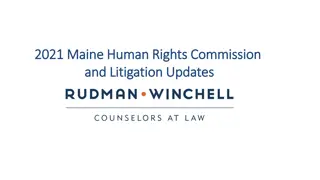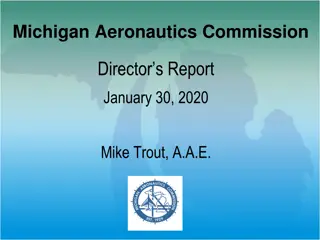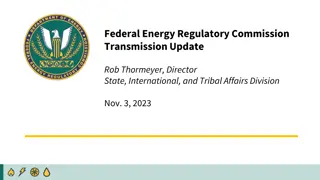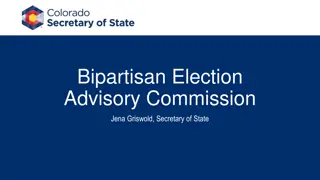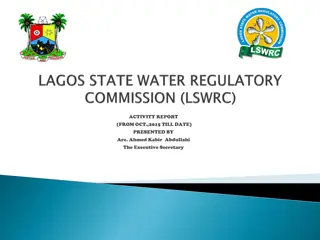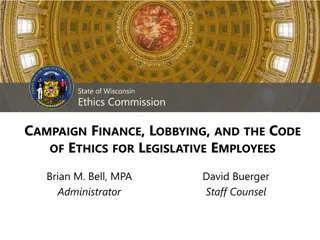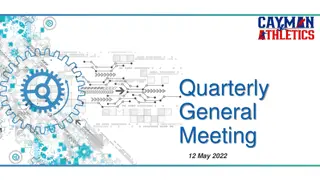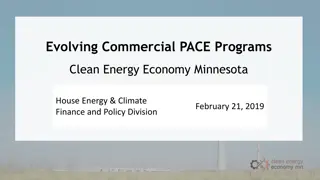California Energy Commission Business Meeting - September 9, 2020
The California Energy Commission is hosting a business meeting on September 9, 2020, at 10:00 a.m. The meeting will cover various topics, including the pledge of allegiance, promoting health in California, taking the census, and remote compliance measures due to COVID-19. Instructions for public comments and participation in the meeting are provided. The agenda includes items like the Consent Calendar with contact details for the National Association of State Energy Officials (NASEO).
Download Presentation

Please find below an Image/Link to download the presentation.
The content on the website is provided AS IS for your information and personal use only. It may not be sold, licensed, or shared on other websites without obtaining consent from the author. Download presentation by click this link. If you encounter any issues during the download, it is possible that the publisher has removed the file from their server.
E N D
Presentation Transcript
California Energy Commission Business Meeting September 9, 2020 10:00 am
Keep California Healthy Wash 3
Take the Census Complete the form by mail, by phone 844-330-2020 or online @ my2020census.gov 4
Remote Compliance Business Meeting held remotely, consistent with Executive Orders N- 25-20 and N-29-20 and the recommendations from California Department of Public Health to encourage physical distancing to slow spread of COVID-19. If Zoom s toll-free phone numbers don t work: Call: 669-900-6833 Meeting ID: 938-6923-0237 If Zoom shuts down, Business Meeting will continue via Verizon. Call: 1-888-823-5065 Passcode: business meeting For remote participation instructions go to CEC s Business Meetings webpage: https://www.energy.ca.gov/proceeding s/business-meetings 5
Public Comment Instructions Pursuant to California Code of Regulations Title 20 1104(e), any person may make oral comment on any agenda item. Two ways to provide comments: 1) Email PublicAdvisor@energy.ca.gov to have the CEC's Public Advisor verbally relate comments during the meeting. OR 2) Call (888) 823-5065. Passcode: "business meeting Comments may be limited to 3 minutes per person and 1 person per organization. Any person wishing to comment on information items or reports (non-voting items) shall reserve their comment for the general public comment portion of the meeting agenda. 1) 2) Tell Operator: name, organization and item number. Tell Operator if you represent: federal or state legislature; tribal nation or California tribal government; state agency; or county/city government. Spell your first and last name. Do not use speaker phone when talking. Mute Zoom while calling to comment. 3) 4) 5) 6
Item 1 - Consent Calendar a. NATIONAL ASSOCIATION OF STATE ENERGY OFFICIALS (NASEO). Contact: Brad Worster 7
Item 1a - Public Comment Instructions Two ways to provide comments: For each voting item, public comments are limited to 3 minutes per person and 1 person per organization. 1) Email PublicAdvisor@energy.ca.gov to have the CEC's Public Advisor verbally relate comments during the meeting. OR 2) Call (888) 823-5065. Passcode: "business meeting 1) 2) Tell Operator: name, organization and item number. Tell Operator if you represent: federal or state legislature; tribal nation or California tribal government; state agency; or county/city government. Spell your first and last name. Do not use speaker phone when talking. Mute Zoom while calling to comment. 3) 4) 5) 8
Item 1b-e Consent Calendar b. HATHITRUST DIGITAL LIBRARY. Contact: Nicole Waugh c. SULPHUR SPRINGS UNION ELEMENTARY SCHOOL DISTRICT. Contact: Tomas Ortiz d. DOWNEY UNIFIED SCHOOL DISTRICT. Contact: Tomas Ortiz e. CALSTART, INC. Contact: Bill Kinney 9
Item 1b-e Public Comment Instructions Two ways to provide comments: For each voting item, public comments are limited to 3 minutes per person and 1 person per organization. 1) Email PublicAdvisor@energy.ca.gov to have the CEC's Public Advisor verbally relate comments during the meeting. OR 2) Call (888) 823-5065. Passcode: "business meeting 1) 2) Tell Operator: name, organization and item number. Tell Operator if you represent: federal or state legislature; tribal nation or California tribal government; state agency; or county/city government. Spell your first and last name. Do not use speaker phone when talking. Mute Zoom while calling to comment. 3) 4) 5) 10
Item 2: Discussion of Energy Commission Progress on Joint Agency Report, Charting a Path to a 100 Percent Clean Electricity Future, Senate Bill 100 (2018) September 9, 2020 Business Meeting Terra Weeks, Sr. Advisor Office of Chair Hochschild Liz Gill, PhD, Electric Generation System Specialist Energy Assessments Division
Benefits to California Under Senate Bill 100, renewable energy and zero-carbon resources shall supply 100 percent of electric retail sales and electricity procured to serve state agencies by December 31, 2045. Public and environmental health benefits by reducing greenhouse gas emissions and air pollution from the electricity sector. Substantial economic and workforce opportunity. 12
Overview The CEC, CPUC, and CARB are developing the Joint-Agency SB 100 report, due to the legislature by January 1, 2021, which will review the policy and provide recommendations for planning and implementation. Activity Estimated Date Kickoff Workshop (Sacramento) September 2019 Scoping Workshop 1: Central Valley (Fresno) September 2019 Scoping Workshop 2: Northern California (Redding) October 2019 Scoping Workshop 3: Southern California (Diamond Bar) October 2019 Technical Workshop (San Francisco) November 2019 Modeling Inputs & Assumptions Workshop (Sacramento) February 2020 Draft Modeling Results Workshop (Remote Only) September 2020 Draft Report Workshop (Remote Only) November 2020 Report due to Legislature January 1, 2021 13
Draft Results Workshop - 9/2/20 Remote attendance only with close to 400 attendees Session 1 included staff presentations on the modeling framework and results Session 2 included three stakeholder panels covering the following perspectives: Grid Planning Implications Equity, Workforce and Additional Considerations Resource Build Requirements Ric O Connell, GridLab (M) Danielle Mills, AWEA Bernadette Del Chiaro, CALSSA Alex Morris, CESA Logan Goldie Scot, BNEF Mateo Jaramillo, Form Energy Shannon Eddy, Large-Scale Solar Association Mike Florio, Gridworks (M) Beth Vaughan, CalCCA Delphine Hou, CAISO James Barner, LADWP Erica Bowman, SCE Aleecia Gutierrez, CEC (M) Shana Lazerow, CBE Elena Krieger, PSE Roger Lin, DACAG Mark Specht, UCS Shrayas Jatkar, CWDB 14
Core Scenario Results As of 2019, there is 80 GW of in-state capacity in California. Load Coverage: Core; Resource Options: All 15
Total Resource Cost 2045 Scenario Costs Scenario Total Resource Cost ($B) Average Cost ( /kWh) 60% RPS $62 14.8 SB 100 Core $66 16.0 Total resource cost (TRC) includes existing system costs (baseline costs), capital investments and operation costs. Demand: High Electrification; Resource Options: All 16
Resource Build Rates Average Build Rate to 2030 Average Build Rate to 2045 All build rates shown in GW/year High Electrification Demand High Electrification Demand Average Build Rate to Date Maximum single year build Reference Demand Reference Demand Load Coverage: Core; Resource Options: All 17
Key Takeaways from Draft Results SB 100 is achievable with existing technologies. Cost reductions and innovation in zero carbon technologies, as well as demand flexibility and energy storage development can further reduce implementation costs. Portfolio diversity is generally valued by the model. Sustained record setting resource build rates will be required to meet SB 100. Natural gas capacity is largely retained, but fleet-wide utilization decreases by 50% compared to a 60% RPS future. Cost reductions and innovation in zero carbon firm resources and storage resources may reduce economic gas fleet retention. 18
Workshop Comments Achieving SB 100 is possible but will be a big push. Requires a coordinated regulatory environment for system planning and to address bottlenecks. Results are directionally useful, but more work is needed to address specific implications, such as reliability, land-use and the location of resources, and equity. Better capture resource potential of emerging and non-generation resources, such as hydrogen, lower-cost geothermal, behind the meter resources, long-duration energy storage, and demand flexibility. Incorporate social costs and non-energy benefits Explore the use of zero-carbon firming resources to further reduce remaining gas and prioritize retirements in disadvantaged communities. Workforce programs require strong partnerships, including with employers. Pre- apprenticeship programs have been a successful model. SB 100 provides a helpful forum to address a range of topics across agencies. 19
Next Steps Staff will review additional written comments (due 9/15) and continue working with the joint agencies to develop the draft report. Draft report workshop planned for later this fall. 20
Item Number 3: ZEV and EV Charger Dashboard September 9, 2020, Business Meeting Siva Gunda, Deputy Director Energy Assessments Division
Overview CEC launched a dashboard to track ZEV and EV charger statistics to track progress toward the state goals Vehicle on-road population ZEV annual and cumulative sales Public and shared-private EV charger counts Provides most up-to-date, accurate and geographically disaggregated information for policy makers, researchers and the public Developed in collaboration with DMV and CARB https://www.energy.ca.gov/zevstats 22
Next Steps Vehicle Population dashboard will be updated annually at a minimum; staff are hoping to update more frequently ZEV Sales dashboard will be updated quarterly, and the next update will occur at the end of October EV Charger dashboard will also be updated quarterly Dashboard will evolve as we receive input and feedback from users https://www.energy.ca.gov/zevstats 24
Item Number: 5. Local Ordinance Applications (19-BSTD-06) September 9, 2020 Business Meeting Danuta Drozdowicz, Efficiency Specialist Efficiency Division, Building Standards Office
Benefits to California Reach Codes local ordinances that exceed the Energy Code provide the opportunity for local jurisdictions to participate directly in the state s efforts to address climate change 26
Overview: The Local Ordinance Approval Process For local building efficiency standards to be enforced: 1. Jurisdiction must file a determination that its standards are cost- effective 2. CEC must find that the local standards require a reduction of energy consumption levels compared to the current statewide Energy Code Staff review application materials to confirm that these criteria are met, and make a recommendation based on the findings 27
2019 Energy Code Approved Local Ordinances To Date 1. 2. 3. 4. 5. 6. 7. 8. 9. 10. Menlo Park 11. Mill Valley 12. Milpitas 13. Mountain View Berkeley Brisbane Cupertino Davis (2) Hayward Healdsburg Los Angeles County Los Gatos Marin County 14. Pacifica 15. Palo Alto 16. Richmond 17. San Francisco 18. San Jose 19. San Luis Obispo 20. San Mateo 21. Santa Monica 22. San Rafael 23. Santa Rosa 24. Saratoga 25. West Hollywood 26. Windsor 28
Local Ordinance Applications Submitted for Approval at this Business Meeting are from: The Town of San Anselmo The County of San Mateo
The Town of San Anselmo Local Ordinance Requires: 1.Newly constructed buildings shall be all- electric or, if mixed fuel, meet higher energy efficiency standards that the 2019 Energy Code. 2.Prewiring for future electric equipment and appliances is required where gas fueled equipment and appliances are installed. 30
The County of San Mateo Local Ordinance Requires: 1. All newly constructed buildings are all-electric with exceptions allowed for laboratories, commercial kitchens, publicly owned emergency shelters, and buildings for which there is no all-electric compliance pathway. 2. Prewiring for electric equipment and appliances is required where gas fueled equipment and appliances are installed. 3. Photovoltaic systems are required on all buildings not subject to the provisions of the Energy Code with exceptions allowed for buildings with vegetative roofs or with limited solar access. 31
Staff Recommendation Staff reviewed application materials from the local jurisdictions Staff found, based on the application material, that the criteria for approval are met Staff recommends that the Town of San Anselmo and the County of San Mateo be approved to enforce its respective local ordinances 32
Item 5 - Public Comment Instructions Two ways to provide comments: For each voting item, public comments are limited to 3 minutes per person and 1 person per organization. 1) Email PublicAdvisor@energy.ca.gov to have the CEC's Public Advisor verbally relate comments during the meeting. OR 2) Call (888) 823-5065. Passcode: "business meeting 1) 2) Tell Operator: name, organization and item number. Tell Operator if you represent: federal or state legislature; tribal nation or California tribal government; state agency; or county/city government. Spell your first and last name. Do not use speaker phone when talking. Mute Zoom while calling to comment. 3) 4) 5) 33
Item 6: Charge Bliss. Demonstrating Long Duration and Title 24-Compatible Energy Storage Technologies GFO-19-306 September 9, 2020 Business Meeting Joseph Sit, Utilities Engineer Energy Research and Development Division, Energy Systems Research Office
Benefits to California Most current energy storage designed for 4 hours Longer duration energy storage needed for: Resilience Use excess renewable generation 35
Overview Solicitation required demonstration of 400kW, 10 hr+ non-lithium ion storage technology Demonstrate 800kW battery system in conjunction with onsite solar Kaiser Permanente Ontario Medical Center 90% of essential power for over 10 hours Funding: $8.3M (CEC) and $7.5M (match) 36
Staff Recommendation Approval of this agreement Approval of supporting CEQA documentation 37
Item 6 - Public Comment Instructions Two ways to provide comments: For each voting item, public comments are limited to 3 minutes per person and 1 person per organization. 1) Email PublicAdvisor@energy.ca.gov to have the CEC's Public Advisor verbally relate comments during the meeting. OR 2) Call (888) 823-5065. Passcode: "business meeting 1) 2) Tell Operator: name, organization and item number. Tell Operator if you represent: federal or state legislature; tribal nation or California tribal government; state agency; or county/city government. Spell your first and last name. Do not use speaker phone when talking. Mute Zoom while calling to comment. 3) 4) 5) 38
Item 10 Nominations due 9/30/20 Go to: www.energy.ca.gov 39
Public Comment Instructions Two ways to provide comments: For each voting item, public comments are limited to 3 minutes per person and 1 person per organization. 1) Email PublicAdvisor@energy.ca.gov to have the CEC's Public Advisor verbally relate comments during the meeting. OR 2) Call (888) 823-5065. Passcode: "business meeting 1) 2) Tell Operator: name, organization and item number. Tell Operator if you represent: federal or state legislature; tribal nation or California tribal government; state agency; or county/city government. Spell your first and last name. Do not use speaker phone when talking. Mute Zoom while calling to comment. 3) 4) 5) 40
Break The September 9, 2020 Business Meeting will not resume earlier than 1:30 PM. We appreciate your patience. 41
Item No. 13: Small Power Plant Exemption for the Sequoia Backup Generating Facility September 9, 2020 Susan Cochran, Hearing Officer Hearing and Policy Unit, Chief Counsel s Office
Sequoia Backup Generating Facility 19-SPPE-03 Application for Small Power Plant Exemption 43
Item 13 - Public Comment Instructions Two ways to provide comments: For each voting item, public comments are limited to 3 minutes per person and 1 person per organization. 1) Email PublicAdvisor@energy.ca.gov to have the CEC's Public Advisor verbally relate comments during the meeting. OR 2) Call (888) 823-5065. Passcode: "business meeting 1) 2) Tell Operator: name, organization and item number. Tell Operator if you represent: federal or state legislature; tribal nation or California tribal government; state agency; or county/city government. Spell your first and last name. Do not use speaker phone when talking. Mute Zoom while calling to comment. 3) 4) 5) 44
In Closed Session Per Government Code Section 11126 The September 9, 2020 Business Meeting will resume shortly. We appreciate your patience. 45
